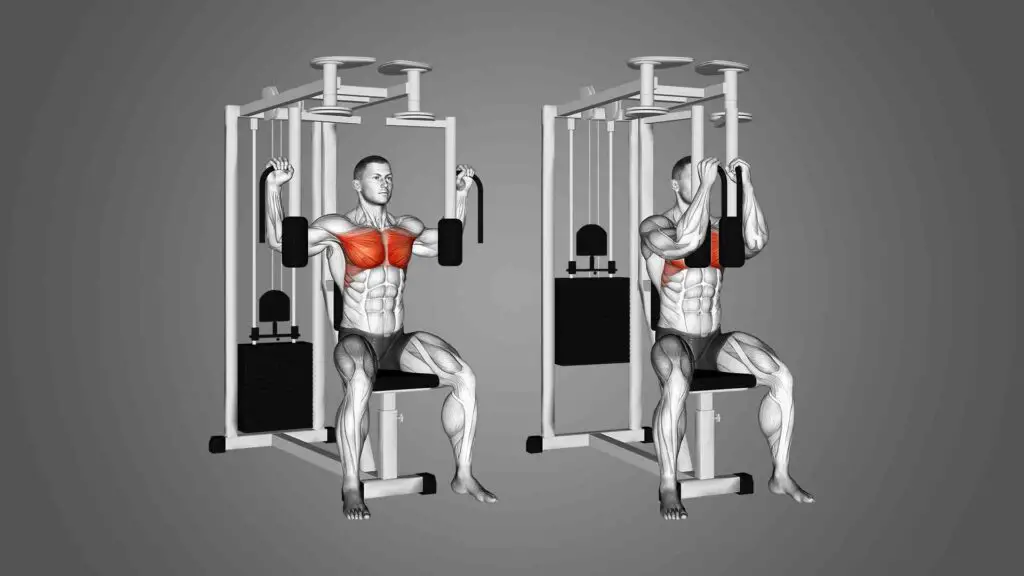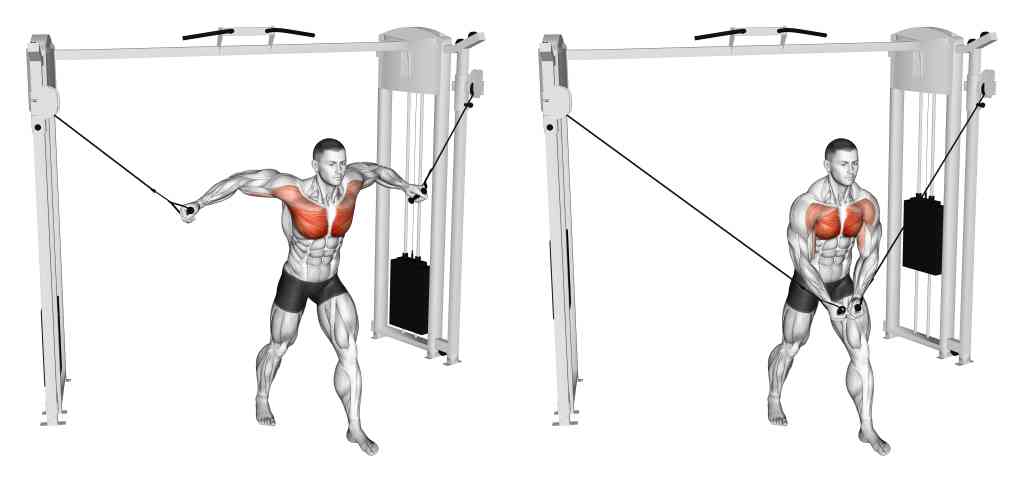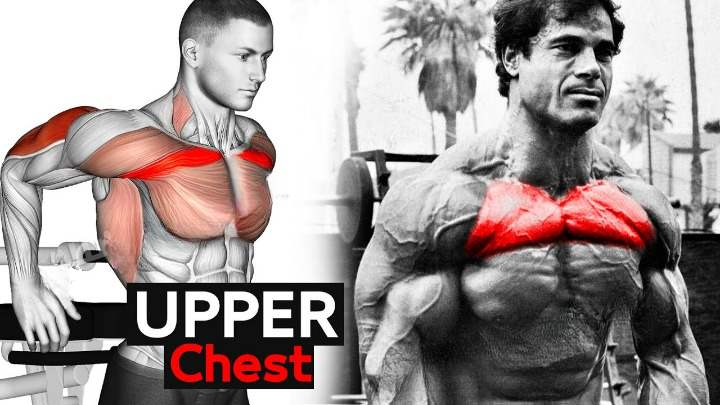Introduction
A pec deck and a cable fly are two types of machines that can help you work out your chest muscles. They both involve bringing your arms together in front of your chest, which activates the pectoralis major and minor muscles, as well as the anterior deltoids and the serratus anterior muscles.
The main difference between a pec deck and a cable fly is the position of your arms and elbows. On a pec deck, you bend your arms at a 90-degree angle and place them on pads, while on a cable fly, you keep your arms straight and hold handles attached to cables.
Both machines have their advantages and disadvantages. A pec deck provides more stability and support, which can reduce the risk of injury and allow you to focus on your chest muscles. A cable fly offers more freedom of movement and variation, which can challenge your muscles from different angles and increase your range of motion.
SHOP FOR THE CABLE MACHINE ON AMAZON
To use a pec deck, you need to select the weight, sit on the platform, press your back against the backrest, grab the handles or pads, and pull them toward your chest while contracting your pecs. To use a cable fly, you need to adjust the height of the pulleys, select the weight, stand in the middle of the machine, grab the handles, and bring them together in front of your chest while keeping your arms slightly bent.
You can also do similar exercises without these machines, such as dumbbell flyes, resistance band chest flyes, or suspension trainer flyes. These alternatives can also work your chest muscles, but they may require more balance and coordination. You can also vary the angle of your flyes by using a bench or an incline or decline position.
Benefits of Pec Deck
The Pec Deck exercise offers several benefits:
- Targeted Muscle Activation: The Pec Deck primarily targets the pectoralis major, a muscle that allows you to swing and bring your arms together. It also works the pectoralis minor, anterior deltoids, and the serratus anterior.
- Strength and Stability: This exercise helps build strength and stability in the chest, which can be beneficial for bodybuilders, athletes, and those looking to improve their overall physical fitness.
- Supporting Muscles Activation: The Pec Deck also activates supporting muscles like the serratus anterior, which opens up and strengthens the backs of your shoulders.
- Intense Chest Workout: The Pec Deck provides an intense chest workout and is superior to other exercises that only work the chest as a bonus.
- Inner Chest Activation: The Pec Deck is great for building the often-neglected inner chest, which can be quite a hard portion of the chest to activate.
Remember to use the correct technique to avoid muscle injury and get the most out of this exercise.
Benefits of Cable Fly
The Cable Fly exercise offers several benefits:
- Targeted Muscle Activation: The Cable Fly primarily targets the pectoralis major, a muscle that allows you to swing and bring your arms together. It also works the pectoralis minor, anterior deltoids, and the serratus anterior.
- Range of Motion: The Cable Fly provides constant tension on the pec muscles through the entire range of motion, which can lead to greater muscle growth and definition.
- Variety in Workout: Doing different variations of the Cable Fly can add variety to your workout routine and help break through plateaus.
- Less Stress on Joints: Compared to other exercises like dumbbell flys, the Cable Fly places less potential stress on the joints.
- Core and Posture: The supported standing structure required for Cable Flys emphasizes control in the core and posture.
Remember to use the correct technique to avoid muscle injury and get the most out of this exercise.
How to Perform Both Exercises
Sure, here’s how to perform both exercises:
Pec Deck

- Adjust the seat so that, when you sit on it and grip the handles, your elbows are level with your shoulders.
- Sit on the machine and place your feet on the floor or the footrests.
- Reach up and back and grab the handles. Place your forearms on the pads.
- Pull your shoulders down and back.
- Gripping the pec deck handles, pull your arms toward your body while contracting your pectoral muscles.
- Bring the handles or arm pads in front of your chest, hold the position for a couple of seconds, and then slowly release back to the starting position.
- Repeat the desired number of reps.
Cable Fly

- Set each pulley on a dual-cable machine at elbow height.
- Stand in the center of the pulleys and grab each handle in one hand.
- Take 1-2 steps forward until you feel the cables slightly pulling you back.
- Keep your feet staggered with one foot forward and your body squared to the front.
- Press the pulleys out straight in front of you.
- With control, let the pulleys go back to the starting position.
SHOP FOR THE PEC DECK MACHINE ON AMAZON
Remember, it’s always important to warm up before starting your workout and cool down afterward.
Comparison of Pec Deck and Cable Fly
The pec deck and cable fly are two exercises that target the chest muscles, but they have some differences in terms of stability, range of motion, and muscle activation. Here is a brief comparison of the two exercises:
- Stability: The pec deck provides more stability than the cable fly, as it has a back support and fixed handles that help you maintain proper form and isolate the chest muscles. The cable fly requires more balance and coordination, as you have to control the cables and prevent them from swinging or pulling you out of alignment.
- Range of motion: The cable fly allows a greater range of motion than the pec deck, as you can adjust the cable height and angle to target different chest parts. The pec deck has a limited range of motion, as it follows a fixed arc that may not suit your biomechanics or preferences.
- Muscle activation: The pec deck and cable fly both activate the chest muscles, but they may emphasize different fibers depending on the position of the handles or cables. The pec deck tends to activate the inner chest more, as it brings the arms closer together in the fully contracted position. The cable fly can activate the upper, middle, or lower chest more, depending on the cable height and the direction of the movement.
- Difficulty: The cable fly is generally more difficult than the pec deck, as it requires more strength, stability, and coordination to perform. The cable fly also allows you to vary the resistance by changing the distance from the cable pulley, whereas the pec deck has a fixed resistance that depends on the weight stack.
- Variety: The cable fly offers more variety than the pec deck, as you can perform different variations of the exercise by changing the cable height, angle, and grip. For example, you can do low-to-high, high-to-low, or straight cable flyes to target different parts of the chest. The pec deck has a limited variety, as it only allows you to do one type of flye movement.
- Safety: The pec deck is generally safer than the cable fly, as it reduces the risk of injury and overstretching the chest muscles. The pec deck has a fixed range of motion that prevents you from going too far or too fast, whereas the cable fly requires you to control the speed and distance of the movement. The cable fly also puts more stress on the shoulder joints, especially if you use a wide grip or a heavy weight.
SHOP FOR THE RESISTANCE BAND ON AMAZON
Both exercises have their pros and cons, and they can be used to complement each other in your chest training. You can alternate between them, or use them as a finisher after your compound movements like the bench press. The best exercise for you depends on your goals, preferences, and individual factors.
Is Pec Deck Better than Cable Fly?

Bodybuilder Derek Lunsford has shared his preference for the Pec Deck over Cable Flyes in his workouts. He believes that the Pec Deck is superior to Cable and Dumbbell Flyes because of how much it emphasizes the chest.
In a video, Lunsford explained his reasoning: “I like to use the Pec Deck machine because it has a back support, and that will help me stabilize my torso as I’m squeezing my chest. I was putting more emphasis on the actual pec muscles rather than swinging with the cables or the free weights.”
He also mentioned that the Pec Deck allows the scapula to “wrap” around the bench since it’s much narrower than a conventional weight bench. This enables a greater range of motion during the flye, further activating his pecs.
While performing the Pec Deck Flye, Lunsford shared some essential tips to activate the chest muscles fully: “I’m really trying to push my back into the pad, so it really stabilizes my upper body as I push. I’m not just pulling [the weight across my chest] using my biceps. My first thought is to push forward.” By pushing the weight forward rather than pulling it across with his biceps, Lunsford activates the pec muscles to their fully contracted position.
Lunsford recommends keeping the palms open when pressing the weight together to make the lift more challenging and allow mind-muscle connection to shorten the fibers of the pecs.
SHOP FOR THE ADJUSTABLE BENCH ON AMAZON
Remember, everyone’s body responds differently to exercises, and what works best for one person may not work as well for another. It’s always important to listen to your body and consult with a fitness professional when starting a new exercise regimen.
Tips for Performing These Exercises
Here are some tips for performing the Pec Deck and Cable Fly exercises correctly and safely:
Pec Deck:
- Seat Height: Adjust the seat height so that the handles are at chest level.
- Use Your Forearms: Place your forearms on the pads or handles of the machine, ensuring your upper arms are parallel to the floor.
- Body Position: Keep your back flat against the pad and do not lean forward while performing the exercise.
- Weight Selection: Use a sensible weight that allows you to perform the exercise with the proper form.
- Movement: Squeeze your arms together in front of your body, pause and squeeze your chest muscles at the peak of the movement.
Cable Fly:
- Weight Selection: Use light to moderate weights and perform medium to high reps, e.g., 12-20 per set.
- Movement: Move smoothly and deliberately to avoid momentum and keep the tension on the target muscles.
- Grip: Do not squeeze the cables excessively tight as this can over-engage the biceps and forearms and reduce the activation of the chest.
- Elbow Position: Always keep a bend in your elbows and do not lower the weight to the point where your muscles start to pain or your shoulders get strained.
Remember, it’s always important to warm up before starting your workout and cool down afterwards. If you’re new to these exercises, you may want to ask a trainer for guidance to ensure you’re using the correct form. This will help you avoid injury and get the most benefit from your workout.
FAQs
Q 1. Can I incorporate both Pec Deck and Cable Fly into my workout routine?
Ans. Yes, you can incorporate both exercises into your workout routine. Both exercises target the chest muscles but from different angles, which can help in building a full, balanced chest.
Q 2. How does the Pec Deck exercise contribute to a greater range of motion?
Ans. The Pec Deck allows the scapula to wrap around the bench since it’s much narrower than a conventional weight bench. This enables a greater range of motion during the fly, further activating the pecs.
Q 3. Why is the Cable Fly considered an isolateral movement and how does it help in addressing muscle imbalance?
Ans. The Cable Fly is considered an isolateral movement because it allows each side of your body to move independently, which can help address any muscle imbalances. It separates itself from compound chest lifts due to its ability to load and isolate your pec muscles from multiple angles, making it an ultra-effective exercise.
Q 4. How often should I perform these exercises?
Ans. You can train your chest up to 3 times per week as part of a total-body fitness regimen. Allow at least 1 rest day between chest workouts. Perform the exercise 2-3 times a week for optimal results.
Q 5. Can beginners perform these exercises?
Ans. Pec Deck is a very accessible exercise and a great movement for beginners. However, the standing cable pulley fly is a moderate-level chest exercise, and thus should not be attempted if you are an absolute beginner to strength training.
Q 6. Are these exercises safe for people with back problems?
Ans. While Pec Deck is considered relatively safe, it’s important to maintain proper form and avoid any movements that cause discomfort or pain. It’s always recommended to consult with a healthcare professional or a certified trainer before starting any new exercise regimen if you have back problems or any other health concerns.
Conclusion
In conclusion, both the Pec Deck and Cable Fly exercises offer unique benefits and can be effective in building and defining the chest muscles. The Pec Deck provides stability and isolation, making it a great choice for those who prefer a more controlled exercise. On the other hand, Cable Flyes offer a greater range of motion and customization, making them ideal for those who prefer a more dynamic workout.
Personal experiences and opinions from fitness enthusiasts and experts, like bodybuilder Derek Lunsford, can provide valuable insights into these exercises. However, it’s important to remember that everyone’s body responds differently to exercises. What works best for one person may not work as well for another.
Lastly, performing these exercises correctly and safely is crucial. Always ensure you’re using the correct form and technique, and listen to your body to avoid injury. If you’re new to these exercises, consider seeking guidance from a fitness professional.

Good day, and welcome to Fitthour. My name is Shubham Vijay, and I am a certified personal trainer and nutrition coach with 6 years of experience in the fitness industry. At Fitthour, we specialize in types of training, such as strength training, cardio, or HIIT, and our mission is to help clients achieve their fitness goals and improve their overall health.




